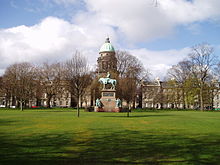- Charlotte Square
-
Charlotte Square is a city square in Edinburgh, Scotland, part of the New Town, designated a UNESCO World Heritage Site. The square is located at the west end of George Street, intended to mirror St. Andrew Square in the east.
Contents
History
Initially named St. George's Square in James Craig's original plan, it was renamed before completion after King George III's Queen and first daughter, to avoid confusion with George Square, in the south of the city. Charlotte Square was the last part of the initial phase of the New Town to be completed in 1820. Much of it was the 1791 design of Robert Adam, who died in 1792, just as building began. The north-west corner (Glenfinlas Street) was only completed in the 1990s, but was done to the original design concept.
Gardens
The memorial in the centre of the garden commemorates Prince Albert, the consort of Queen Victoria, and features an equestrian statue of the prince, in field marshal's uniform, by Sir John Steell. It was unveiled by Queen Victoria herself in 1876.[1] The stone plinth was designed by the architect David Bryce and the four corner figures are by D.W. Stevenson (Science and Learning/Labour), Clark Stanton (Army and Navy) and William Brodie (Nobility).[2]
The central open space is a private garden, available to owners of the surrounding properties. For the last three weeks in August each year Charlotte Square gardens are the site of the Edinburgh International Book Festival.
Buildings
On the north side, No. 5 was the home of John Crichton-Stuart, 4th Marquess of Bute (1881–1947), who bought it in 1903 and gave it to the National Trust for Scotland on his death. It was the Trust headquarters from 1949 to 2000. Bute did much to promote the preservation of the Square. No. 5 is now the headquarters of the Edinburgh World Heritage Trust.[3]
Nos. 6 and 7 are also owned by the National Trust for Scotland. No.6, Bute House is the official residence of the First Minister of Scotland. In 1806 it was home to Sir John Sinclair creator of the first Statistical Account of Scotland. No. 7 was internally restored by the Trust in 1975 to its original state, and is open to the public as The Georgian House.[4] The upper floor was formerly the official residence of the Moderator of the General Assembly of the Church of Scotland. The building includes one fireplace brought from Hill of Tarvit in Fife in 1975.
West Register House, formerly St. George's Church, forms the centre of the west side. It was designed by the architect Robert Reid in 1811, broadly to Adam's plan. The church opened in 1814 and was converted to its current use in 1964. It is one of three main buildings of the National Archives of Scotland
Residents
James Syme, the surgeon, lived at No.9 and his son-in-law Joseph Lister, lived there from 1870-1877. No. 13 was home to Sir William Fettes and No. 14 the house of Whig lawyer, historian and conservationist Lord Cockburn. Viscount Haldane was born at No.17 and another soldier, Field Marshal Earl Haig, was born at No. 24. Robert Reid designed No. 44 as his own home. Pioneer of the telephone, Alexander Graham Bell, was born in nearby South Charlotte Street.
References
- ^ Gunnis, Rupert. Dictionary of British Sculptors, 1660-1857
- ^ McWilliam, Colin (1984). Edinburgh. The Buildings of Scotland. Yale.
- ^ "Contact us". Edinburgh World Heritage Trust. http://www.ewht.org.uk/what-we-do/contact-us.
- ^ "Georgian House". National Trust for Scotland. http://www.nts.org.uk/Property/56/.
External links
Coordinates: 55°57′06″N 3°12′28″W / 55.951776°N 3.207657°W
Categories:- Buildings and structures completed in 1820
- Category A listed buildings in Scotland
- Listed buildings in Edinburgh
- New Town, Edinburgh
- Squares in Edinburgh
Wikimedia Foundation. 2010.


